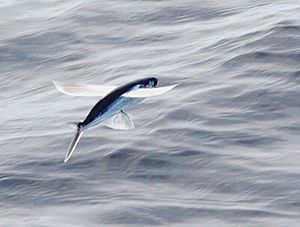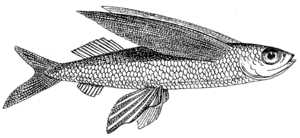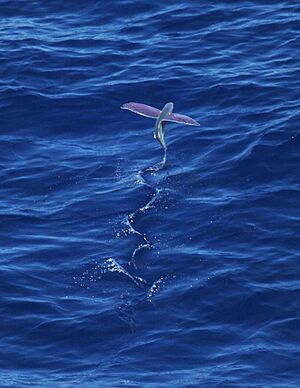Flying fish facts for kids
Quick facts for kids Flyingfish |
|
|---|---|
 |
|
| Sailfin flying-fish Parexocoetus brachypterus |
|
| Scientific classification | |
| Kingdom: | |
| Phylum: | |
| Class: | |
| Order: | |
| Family: |
Exocoetidae
|
Flying fish are amazing ocean creatures. They belong to a family called Exocoetidae. There are about 50 different kinds of flying fish. They live all over the world in warm ocean waters.
These fish are famous for their special ability to glide through the air. They are usually small, growing up to about 45 cm (18 inches) long. They have stiff, wing-like fins and a tail that is forked unevenly.
Flying fish do not actually flap their fins to fly like birds. Instead, they swim very fast towards the surface of the water. When they burst out of the water, they spread their large fins and glide. They can glide for surprisingly long distances! Scientists believe this gliding helps them escape from predators. The earliest known flying fish lived a very long time ago, during the Middle Triassic period.
Contents
Flying Fish: Ocean Gliders!
Where Do Flying Fish Live?
Flying fish can be found in all the world's oceans. They especially love tropical and warm subtropical waters. Their most amazing feature is their pectoral fins. These fins are much larger than those of most other fish. They allow the fish to leap out of the water and glide through the air. This helps them hide and escape from animals that want to eat them. Their glides are usually around 50 meters (160 feet) long.
How Do Flying Fish Glide?
To launch themselves out of the water, a flying fish wiggles its tail very quickly. It can move its tail up to 70 times per second! Then, it spreads its pectoral fins. It tilts them slightly upwards, which helps the fish get lift, just like an airplane wing.
When the glide is over, the fish can fold its fins and drop back into the sea. Or, it can dip its tail into the water to push off again. This lets it start another glide, sometimes changing direction! The shape of their "wings" is curved, much like a bird's wing, which helps them fly. Flying fish can even stay in the air longer by gliding into updrafts. These are rising air currents created by a mix of air and ocean currents.
There are different types of flying fish. The Exocoetus genus has one pair of fins and a sleek body. This design helps them go very fast. The Cypselurus genus has a flatter body and two pairs of fins. This design helps them stay in the air for longer. From the early 1900s to the 1930s, scientists even studied flying fish. They hoped to use them as models to help design airplanes!
What Do Flying Fish Eat?
Flying fish mostly eat tiny ocean creatures called plankton. But they also have many predators. Animals that hunt flying fish include dolphins, tuna, marlin, birds, squids, and porpoises.
Incredible Gliding Records
In May 2008, a Japanese TV crew filmed a flying fish. They called it "Icarfish." This amazing fish was off the coast of Yakushima Island in Japan. It stayed in flight for an incredible 45 seconds! This broke the previous record of 42 seconds.
Flying fish can use the rising air at the front of waves. This helps them glide for distances of at least 400 meters (1,300 feet). They can also reach speeds of more than 70 kilometers per hour (43 mph). The highest they can glide is about 6 meters (20 feet) above the sea surface. Sometimes, they even land on the decks of ships!
Flying Fish and People
People catch flying fish for food in many places. This includes Japan, Vietnam, and China. They use special nets called gillnetting. In Indonesia and India, they use dipnets.
In Japanese cuisine, flying fish are often dried to preserve them. The roe (eggs) of the Japanese flying fish, Cheilopogon agoo, is used to make some types of sushi. These eggs are known as tobiko. Flying fish are also a very important food for the Tao people who live on Orchid Island, Taiwan. In Barbados, flying fish are part of the national dish. It's called cou-cou and flying fish.
In the Solomon Islands, people catch flying fish while they are gliding. They use nets held from outrigger canoes. They attract the fish with the light of torches. This type of fishing is only done when there is no moonlight.
Images for kids
-
Dried flying fish for sale in Tokyo.
See also
 In Spanish: Pez volador para niños
In Spanish: Pez volador para niños





